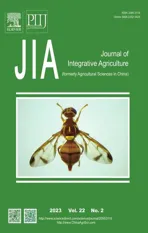Drip fertigation and plant hedgerows significantly reduce nitrogen and phosphorus losses and maintain high fruit yields in intensive orchards
2023-02-03SONGKeQlNQinYANGYefengSUNLijuanSUNYafeiZHENGXianqingWeiguangXUEYong
SONG Ke ,QlN Qin ,YANG Ye-feng ,SUN Li-juan ,SUN Ya-fei ,ZHENG Xian-qing ,LÜ Wei-guang,XUE Yong
1 Eco-Environmental Protection Research Institute,Shanghai Academy of Agricultural Sciences,Shanghai 201403,P.R.China
2 Pudong New District Agro-Technology Extension Service Center,Shanghai 201300,P.R.China
Abstract A field experiment was carried out to evaluate the effects of drip fertigation combined with plant hedgerows on nitrogen and phosphorus runoff losses in intensive pear orchards in the Tai Lake Basin.Nitrogen and phosphorus runoff over a whole year were measured by using successional runoff water collection devices.The four experimental treatments were conventional fertilization (CK),drip fertigation (DF),conventional fertilization combined with plant hedgerows (C+H),and drip fertigation combined with plant hedgerows (D+H).The results from one year of continuous monitoring showed a significant positive correlation between precipitation and surface runoff discharge.Surface runoff discharge under the treatments without plant hedgerows totaled 15.86% of precipitation,while surface runoff discharge under the treatments with plant hedgerows totaled 12.82% of precipitation.Plant hedgerows reduced the number of runoff events and the amount of surface runoff.Precipitation is the main driving force for the loss of nitrogen and phosphorus in surface runoff,and fertilization is an important factor affecting the losses of nitrogen and phosphorus.In CK,approximately 7.36% of nitrogen and 2.63% of phosphorus from fertilization entered the surface water through runoff.Drip fertigation reduced the accumulation of nitrogen and phosphorus in the surface soil and lowered the runoff loss concentrations of total nitrogen(TN) and total phosphorus (TP).Drip fertigation combined with plant hedgerows significantly reduced the overall TN and TP losses by 45.38 and 36.81%,respectively,in comparison to the CK totals.Drip fertigation increased the vertical migration depth of nitrogen and phosphorus nutrients and reduced the accumulation of nitrogen and phosphorus in the surface soil,which increased the pear yield.The promotion of drip fertigation combined with plant hedgerows will greatly reduce the losses of nitrogen and phosphorus to runoff and maintain the high fruit yields in the intensive orchards of the Tai Lake Basin.
Keywords: drip fertigation,plant hedgerows,surface runoff,nitrogen and phosphorus losses,fruit yields
1.lntroduction
Agricultural nonpoint source (AGNPS) pollution is a serious environmental problem today that is prevalent worldwide.Nitrogen and phosphorus flow into rivers,reservoirs and lakes from farmlands through farmland drainage and surface runoff;and these processes are important factors leading to AGNPS pollution (Chenet al.2015;Khaliliet al.2015;Vymazal and Březinová 2018).In China,excessive chemical fertilizer use is common in many areas with relatively developed agricultural activities and high economic levels,leading to the accumulation of large amounts of nitrogen and phosphorus in the soils.Under rainfall or irrigation,the nitrogen and phosphorus present in these soils are lost to the surface water,leading to AGNPS pollution.Therefore,nitrogen and phosphorus in farmland soils are important nonpoint source pollutants,and rainfall and irrigation are the main forces driving nitrogen and phosphorus losses.Since agriculture has become more intensified and fertilizer application has continuously increased,orchards and vegetable fields with high AGNPS pollution risks have become important sources from which nitrogen and phosphorus pollutants can enter the waters of major river basins.According to data obtained from the National Bureau of Statistics of China,the country’s orchards covered a total of 12.26 million ha in 2019,accounting for approximately one-tenth of the total arable land (NBSC 2019).Fruit trees provide great economic benefits,but the excessive application of chemical fertilizers often results in large amounts of nitrogen and phosphorus accumulating in orchard soil,and these nutrients can easily be lost to surface water during rainfall and irrigation,thereby causing environmental problems such as water eutrophication.However,relatively few studies have focused on nonpoint source pollution in orchards,and quantitative research results on source reduction combined with process interception are particularly lacking.
Drip fertigation is a technology that integrates irrigation and fertilization.Its main mechanism uses water as a carrier to cause the migration of water-soluble nutrients to crop roots through two processes: diffusion and mass flow (Jiuet al.2012;Thompsonet al.2018).Compared with traditional fertilization methods,drip fertigation can not only improve fruit yield but also reduce the application and improve the utilization efficiency of water and fertilizer.However,this fertilization method also leads to changes in soil management through its impact on various soil processes,such as runoff,erosion,oxidation,and mineralization (Zhanget al.2015;Lvet al.2019).Especially for the deep-rooted crops in orchards,the coupling of water and fertilizer can significantly reduce soil surface water evaporation and water loss,and promote the vertical migration of water and nutrients.However,the existing research mostly focuses on the effect of drip fertigation on the improvements in the yield and quality of fruit trees (Senthilkumaret al.2017) and the migration and transformation of water and fertilizer in soil.Since few reports have focused on the reduction in nitrogen and phosphorus surface runoff loss by drip fertigation,little is known about the use of drip fertigation to reduce AGNPS pollution.
The role of plant hedgerows in reducing soil erosion is widely recognized.Plant hedgerows can intercept and reduce the energy of raindrops and act as a physical barrier for runoff and sediment migration on the surface,thereby reducing runoff and sediment transport (Kervroëdanet al.2019).Keesstraet al.(2016) conducted a field-simulated rainfall experiment on sloping farmland after three treatments (tillage weeding,herbicide weeding,and hedgerow installation),and the results showed that the runoff coefficient,total runoff,sediment volume and soil erosion of the plant hedgerow treatment were significantly lower than those of the other plots.Li J Qet al.(2015) reported that the roots and litter of plant hedgerows can effectively intercept clay particles and reduce the loss of nutrients such as nitrogen and phosphorus.The results showed that plant hedgerows are an effective management option for reducing runoff and nitrogen loss.For many years,numerous scholars have conducted extensive research on soil physicochemical properties and soil erosion reduction mechanisms based on different soil types and plant hedgerow configurations,but these studies have mainly focused on sloping farmland areas with severe soil erosion and do not include quantitative research on the prevention and control of nitrogen and phosphorus loss by plant hedgerows in plain river network areas.
Tai Lake is the third-largest freshwater lake in China.It is located in China’s most densely populated and economically developed area.As the lives of citizens are improving,the residents’ demand for fruits and vegetables is increasing,and the intensive farmland areas,such as orchards,are also increasing.According to our survey of 18 orchards in three provinces (Jiangsu,Zhejiang and Anhui) and one city (Shanghai) in the Tai Lake Basin,the average amount of pure nitrogenous fertilizer used in intensive orchards is 565 kg ha-1yr-1,and the average amount of pure phosphate fertilizer is 362 kg ha-1yr-1.These values are approximately 2-3 times those applied to field crops.The utilization rate of nitrogen fertilizer is approximately 20% in intensive orchards,and that of phosphate fertilizer is only 15%;and these values are much lower than the average fertilizer utilization rate of field crops (35.2%).Large amounts of chemical fertilizers and the low utilization efficiency of these fertilizers have become the most critical potential factors leading to water eutrophication (Wang Jet al.2019).To control the AGNPS pollution caused by the excessive application of chemical fertilizers,the local government has vigorously promoted drip fertigation and plant hedgerow interception technologies in orchards.However,the role of these technologies in reducing AGNPS pollution remains unclear.
Our previous studies have confirmed that drip fertigation significantly reduces water and fertilizer usage and improves water and fertilizer use efficiency (Xiao and Ni 2016;Biet al.2017).However,we still lack quantitative data on the contribution of drip fertigation combined with plant hedgerows to the reduction of nitrogen and phosphorus runoff in orchards.Here,we hypothesized that the combined application of drip fertigation and plant hedgerows could significantly reduce nitrogen and phosphorus runoff losses in orchards and increase fruit yield.To test this hypothesis,we conducted a 1-yr positioning experiment to determine the effects of different fertilization methods combined with plant hedgerows on reducing nitrogen and phosphorus runoff losses and improving fruit yield.The results provide data support for the widespread promotion and application of drip fertigation and plant hedgerow models.
2.Materials and methods
2.1.Study sites
The study sites are located at the AGNPS Experimental Station (120°13´22´´E,31°7´29´´N) on Xishan Island in Tai Lake,Suzhou City,Jiangsu Province.Xishan Island is the largest island in Tai Lake and has a land area of 79.8 km2.This region represents a typical southern hilly area.Fruit trees and tea trees are the most important planted crops.The area is located in the northern subtropical zone of China and has a mild,humid monsoon climate.The annual average temperature is 16.8°C,the annual average precipitation is 1 108.5 mm,the annual average sunshine duration is 2 209 hours,and the frost-free period is approximately 236 days.Pear trees were planted at the experimental base in October 2011 and cover a total area of 5.4 ha.This area is close to Tai Lake,and has no slope and an altitude of 3.4 m.The soil in the study area is swamp soil;and in the cultivated soil,the organic matter content is 21.64 g kg-1,the total nitrogen content is 1.29 g kg-1,the total phosphorus content is 0.93 g kg-1,the alkali-hydrolyzable nitrogen (AN) content is 55.24 mg kg-1,the available phosphorus (AP) content is 34.85 mg kg-1,the available potassium (AK) content is 94.22 mg kg-1,and the pH is 6.68 (at a water-soil ratio of 5:1).
2.2.Experimental design
The experiment began in October 2018.According to the different fertilization methods used and the presence or absence of a plant hedgerow setup,four treatments were established: T1,conventional fertilization (CK);T2,drip fertigation (DF);T3,conventional fertilization+plant hedgerows (C+H);and T4,drip fertigation+plant hedgerows (D+H).The specific research design is shown in Fig.1.The control system and fertilizer tank for drip irrigation were located in the center of the pear tree area,and drip fertigation pipes were laid along the pear trees.For drip fertigation,water and fertilizer were dripped into the 5-10 cm soil layer through drip irrigation pipes,and drip arrows were inserted into the soil.Three plots were established for each treatment.Each plot included four pear tree planting fields and three field ditches.The area of each plot was 1 080 m2,and 30 pear trees were planted in each planting field;so,the field area was 6×36=216 m2and the field ditch area was 2×36=72 m2.The field ditches were inverted trapezoids that were 1.6 m wide at the bottom,2 m wide at the top,and 0.6 m high.The two oblique sides were constructed with cement.Each field ditch was connected to the main ditch at one end and was closed at the other end.The four main ditches (each with dimensions of 30 m in length,2 m in width,60 m2in area,and 0.8 m in depth) were connected to the field ditches in each plot,but the main ditches were not connected or drained independently.
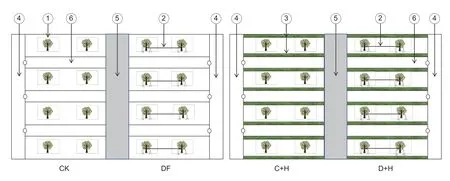
Fig.1 Schematic diagram of the experimental design.The experimental plots used in different treatments have the following labels:①pear tree,② drip fertigation,③plant hedgerows,④ main ditch,⑤ field road,and ⑥ field ditch.CK,conventional fertilization;DF,drip fertigation;C+H,conventional fertilization+plant hedgerows;D+H,drip fertigation+plant hedgerows.
2.3.Hedgerow construction
The plant hedgerows were set up in June 2018.Ophiopogon japonicus,a perennial evergreen plant with a height of 10-50 cm,was selected for the hedgerows.This plant has many excellent traits,such as its evergreen characteristics,shade tolerance,cold tolerance,drought tolerance,and resistance to diseases and insect pests.It can grow normally from 5-30°C.On both sides of each pear tree plot,four rows ofO.japonicuswere planted evenly along the ditch direction to form a hedgerow strip.Each strip was 50-60 cm wide and the same length as the plot,and the runoff water was discharged from each plot in the vertical direction.The plant hedgerows were not fertilized,and the nutrients in these hedgerows were derived from the absorption of the nitrogen and phosphorus present in runoff water.Artificial weeding was carried out regularly.
2.4.Fertilization
Fertilization was divided into base fertilizer application and topdressing application.The base fertilizer was commercial organic fertilizer (Shanghai Lianke Organic Fertilizer Factory,N:P2O5:K2O=1.53:2.94:1.78),which was applied after the pear fruits were harvested in autumn (late October to early November).The fertilizer was placed into a 30-cm wide ring trench,which was consistent with the tree trunk radius,and the soil was backfilled and covered.The topdressing application was divided into two methods for the traditional topdressing and drip fertigation applications.Urea (Jiangsu Linggu Chemical Co.,Ltd.,N content of 46.7%) and compound fertilizer (Jiangsu Linggu Chemical Co.,Ltd.,N:P:K=15:15:15) were used in the traditional topdressing application.The fertilization method was the same as that used for the base fertilizer application,and irrigation was conducted after fertilization.Water-soluble urea (Shike Biological Technology (Shanghai)Co.,Ltd.,N content of 46.7%) and water-soluble compound fertilizer (Shike Biological Technology (Shanghai) Co.,Ltd.,N:P:K=20:20:20) were applied in the drip fertigation method.The fertilizer was dissolved in water and applied to the 5-10 cm soil layer with drip fertigation.The drip fertigation treatments (DF and D+H) were irrigated when the fertilization occurred,and the conventional fertilization treatments (CK and C+H) were irrigated with a drip system after fertilization (and the irrigation water did not contain fertilizers).The irrigation and fertilization amounts,times and pure nutrient contents are listed in Table 1.
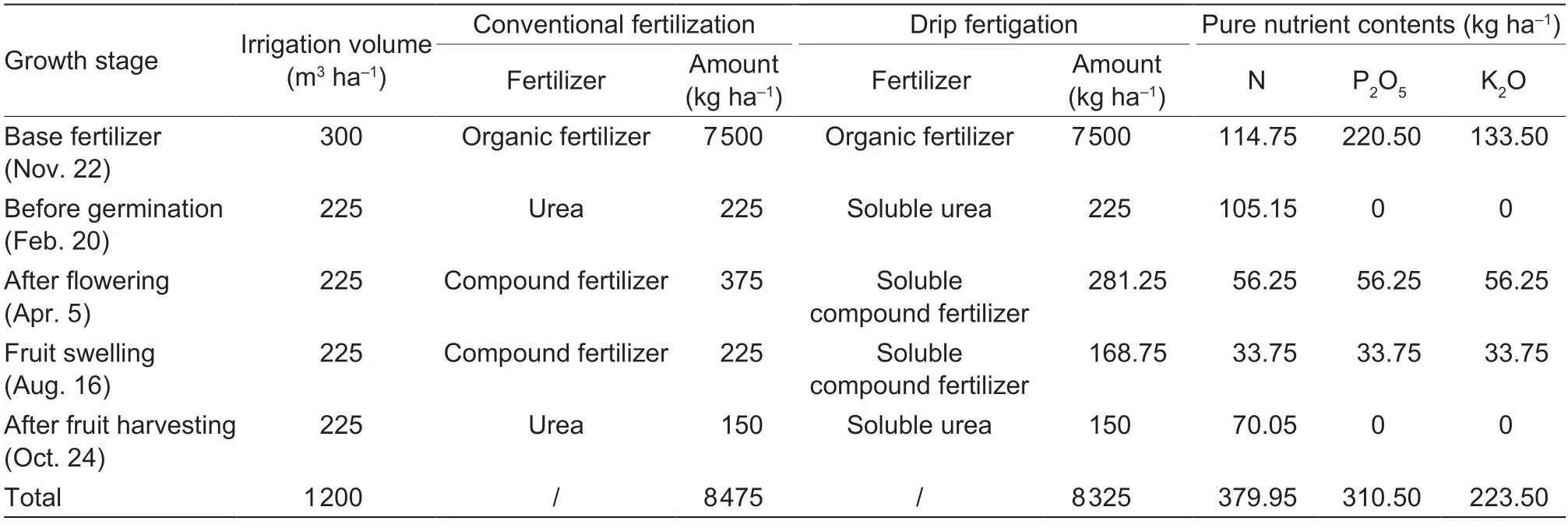
Table 1 Fertilization applied in the different treatments
2.5.Sample collection
In this experiment,the monitoring plots were set up in October 2018.Runoff water collection devices were subsequently installed,and fertilization management and pretests were carried out.As shown in Fig.2,the area of the monitoring plot designed to collect runoff water was 4.8×3=14.4 m2,and two pear trees were planted in each monitoring plot.Surface runoff was obtained from these runoff collectors.Each surface runoff collectorwas a rectangular parallelepiped-shaped stainless steel collection trough with a square cross-section of 20 cm,a length of 200 cm,a height of 20 cm on three sides,and a water inlet height of 18 cm on one side.A diversion pipe with a diameter of 10 cm was installed at one end of each collection trough.The runoff water flowed through the diversion pipe into a water storage bucket that was buried in the soil.The water storage bucket was a circular plastic bucket with a volume of 120 L.During installation,a 20 cm×20 cm×200 cm trench was excavated at the edge of each pear tree plot,and a collector was placed in each trench.The side that was 18 cm high was flush with the ground so that it received runoff water,and the other three sides supported the roof which prevented precipitation from entering the collector.The water storage bucket was buried below the ground to store the runoff water collected by the collection trough.
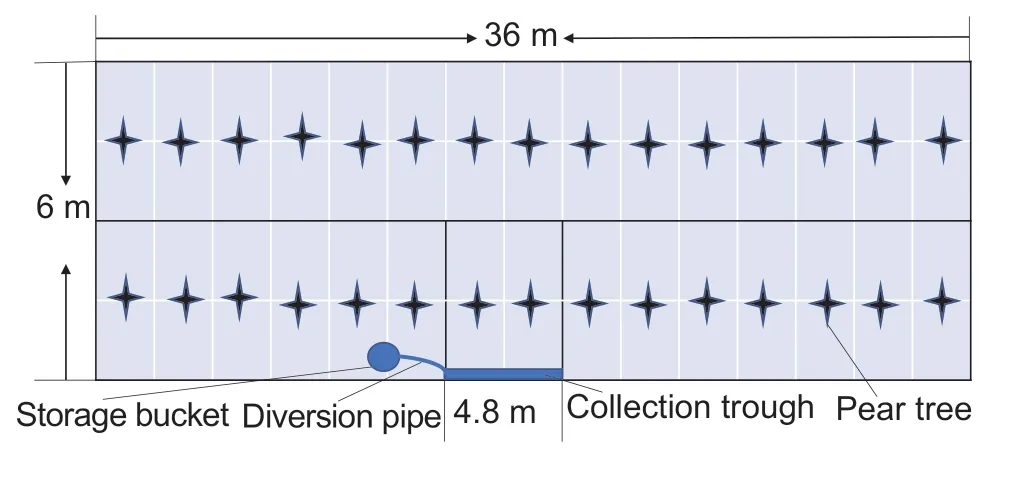
Fig.2 Schematic diagram of the runoff water collection devices.
From July 2019 to June 2020,surface runoff was collected from each storage bucket in each monitoring plot after each rainfall event.We first measured the height of the water stored in each bucket,calculated the water capacity,and then stirred the water with a stirring rod.Plastic bottles of 500 mL were used to collect the water and then labeled.After collection,the water in the bucket was discharged with a small water pump.Each rainfall event was recorded during surface runoff collection.All collected water samples were placed in a mobile refrigerator and transported back to the laboratory for analysis.The total nitrogen (TN) and total phosphorous (TP)concentrations in each sample were determined.TN was determined by potassium persulfate oxidation-ultraviolet spectrophotometry,and TP was determined by ammonium molybdate spectrophotometry (Lu 2000).The soil AN was determined using the method described by Robertset al.(2011),while AP was determined by the method published in Olsen and Sommers (1982).
2.6.Pear yield
In this experiment,the pear yields were determined during the fruit-ripening periods on September 28,2019,and September 26,2020.In each treatment,nine pear trees were randomly selected,and all pears on these trees were picked and weighed.The number of fruits per plant,fruit weight and yield per plant were all determined.Then,the total yield obtained under each treatment was calculated.
2.7.Data calculation and analysis
During the 1-year monitoring period,the TN and TP emission fluxes were calculated using the following fomula:
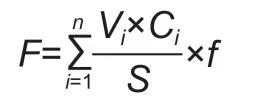
whereF(kg ha-1) is the discharge flux of TN or TP in the surface runoff;nis the number of surface runoff generations in the monitoring period;Vi(L) is the amount of water produced in theith runoff event;Ci(mg L-1)is the concentration of TN or TP in the water of theith runoff event;S(m2) is the surface runoff monitoring plot area;andfis the coefficient used to convert the TN or TP emission flux (mg m-2) of the monitoring plot to the emission flux per hectare (kg ha-1).
After the data were collated using Microsoft Excel 2010,the SPSS 17.0 Software package was used for the analysis of variance (ANOVA).A significant difference test was performed by a one-way ANOVA in SPSS 17.0 at theP<0.05 level.Multiple comparisons between different treatments were performed using the Tukey method.The graphics were produced in Origin 8.0 Software.
3.Results
3.1.Surface runoff
An analysis of the precipitation and surface runoff characteristics in the study area showed that the total precipitation was 1 186 mm during the 1-yr monitoring period,which was similar to the annual average precipitation in the Tai Lake Basin.Thus,the study year was a normal precipitation year.As shown in Fig.3-A,surface runoff occurred 51 times in the treatments without plant hedgerows,and the surface runoff discharge was 188.09 mm,which was 15.86% of the total precipitation.Surface runoff discharge increased with increasing precipitation when surface runoff occurred,and the precipitation and surface runoff discharge were significantly positively correlated (Fig.4-A),withY=0.472X-3.740 (R2=0.902).As shown in Fig.3-B,surface runoff occurred 43 times in the treatments with plant hedgerows,and the surface runoff discharge was 152.01 mm,which was 12.82% of the total precipitation.Precipitation and surface runoff discharge were also significantly positively correlated (Fig.4-B),withY=0.450X-3.993 (R2=0.839).Compared to the treatments without plant hedgerows,plant hedgerows reduced the amount of surface runoff and the overall runoff loss.Specifically,the amount of runoff was reduced by a factor of 8,and the overall runoff loss was reduced by 19.18%.The results also showed that July to September is the rainy season in the Tai Lake Basin,and this period is when the surface runoff mainly occurs in the orchards.During the monitoring period,the precipitation from July to September accounted for approximately 40.12% of the total annual precipitation.Surface runoff occurred 18 times in the treatments without plant hedgerows,accounting for 35.29% of the total surface runoff,and surface runoff discharge accounted for 41.80% of the total surface runoff discharge.Surface runoff occurred 15 times in the treatments with plant hedgerows,accounting for 34.88% of the total surface runoff times,and surface runoff discharge accounted for 42.63% of the total surface runoff discharge.

Fig.3 Surface runoff and the relationship with precipitation without plant hedgerows (A) and with plant hedgerows (B).
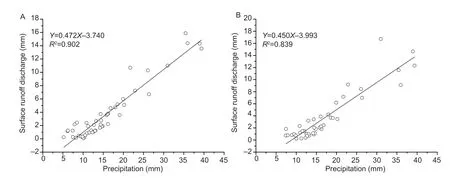
Fig.4 Correlation analysis between surface runoff and precipitation without plant hedgerows (A) and with plant hedgerows (B).Each circle is the average of six replicates for the two treatments without plant hedgerows (CK and DF) or with plant hedgerows(C+H and D+H).CK,conventional fertilization;DF,drip fertigation;C+H,conventional fertilization combined with plant hedgerows;D+H,drip fertigation combined with plant hedgerows.
3.2.TN and TP in surface runoff
We measured the concentrations of TN and TP in the surface runoff samples.As shown in Fig.5-A,the average concentration of TN in the surface runoff for CK was 8.83 mg L-1,and the average concentration of TN for DF was 6.071 mg L-1,which was 31.23%lower than that for CK.The average concentration of TN for C+H was 7.350 mg L-1,which was 16.74%lower than that for CK.The average concentration of TN for D+H was 4.209 mg L-1,which was 52.32%lower than that for CK.The concentration of TP in the surface runoff for each of the different treatments is shown in Fig.5-B.Similar to the TN trend,the average concentration of TP for CK was 1.235 mg L-1,and the average concentration of TP for DF was 0.924 mg L-1,which was 25.18% lower than that for CK.The average concentration of TP for C+H was 1.067 mg L-1,which was 13.60% lower than that for CK.The average concentration of TP for D+H was 0.693 mg L-1,which was 43.89% lower than that for CK.
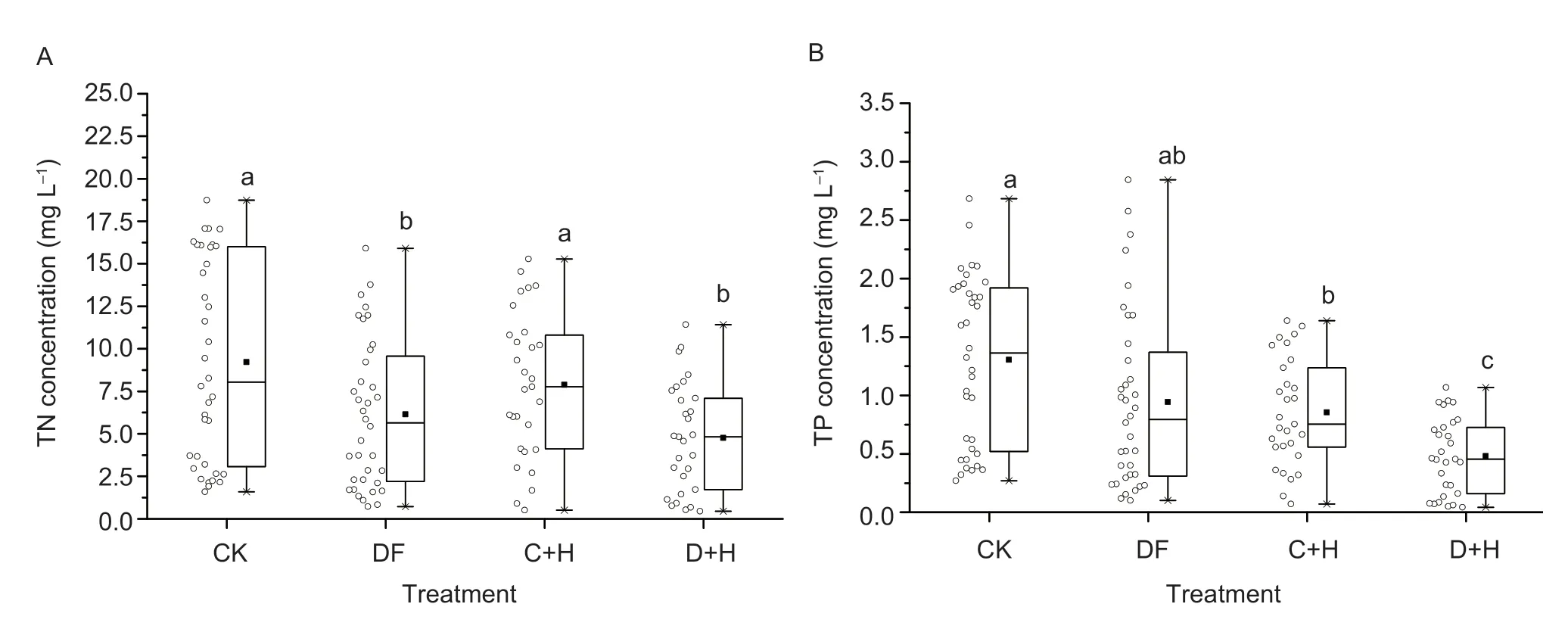
Fig.5 The total nitrogen (TN) (A) and total phosphorous (TP) (B) concentrations in surface runoff under the different treatments.CK,conventional fertilization;DF,drip fertigation;C+H,conventional fertilization combined with plant hedgerows;D+H,drip fertigation combined with plant hedgerows.Each point is the average of three replicates for the same treatment.Bars are SE.Treatments indicated by the same letter are not significantly different at the P≤0.05 level on the basis of one-way ANOVA results.
3.3.Overall TN and TP losses
From July 2019 to June 2020,we measured the amount of runoff collected during each runoff event,analyzed the TN and TP concentrations in runoff,and calculated the corresponding TN and TP emission fluxes (Table 2).The overall TN loss for CK was the highest,accounting for approximately 7.36% of the total nitrogen application.Drip fertigation and plant hedgerows both significantly reduced the TN loss.Notably,the losses were reduced by 34.24 and 20.60%,respectively,compared with those for CK.The overall TN loss for D+H was the lowest,and it was 45.38% lower than that for CK.Compared with TN loss,the overall TP loss was significantly reduced,but the order of the losses for the different treatments was the same.Specifically,the overall TP loss for CK was the highest,accounting for approximately 2.63% of the total phosphorus application.The overall TP loss for C+H accounted for 2.29% of the total phosphorus that was applied,and there was no significant difference between this result and that for CK.The overall TP loss for DF was 22.47% lower than that for CK.The overall TP loss for D+H was the lowest,and it was 36.80% lower than that for CK.

Table 2 The N and P runoff loss loads under the different treatments

Table 3 Pear yields under the different treatments
3.4.AN and AP in soil
To evaluate the effects of different fertilization methods and the presence of plant hedgerows on soil nitrogen and phosphorus,the soil samples collected in October 2018(before the start of the experiment) and in June 2020(1 yr following the monitoring period) were analyzed.No obvious difference in AN or AP was found among the different treatments in the samples from the same soil layer collected in October 2018.The average AN contents in the three soil layers of 0-5,5-20 and 20-40 cm were 108.73,63.74 and 36.14 mg kg-1,respectively.The AN contents measured in the soils under the different treatments in June 2020 are shown in Fig.6-A.CK had a significantly higher AN content than DF in the 0-5-cm soil layer,while drip fertigation resulted in higher AN contents than conventional fertilization in the 5-20-and 20-40-cm soil layers.Therefore,plant hedgerows did not significantly affect the AN content in the soil.The AP contents showed a trend that was similar to the AN content trend.As shown in Fig.6-B,the AP content under CK was significantly higher than that under DF in the 0-5-cm soil layer,while the AP contents under DF in the 5-20-and 20-40-cm soil layers were significantly higher than those under CK.
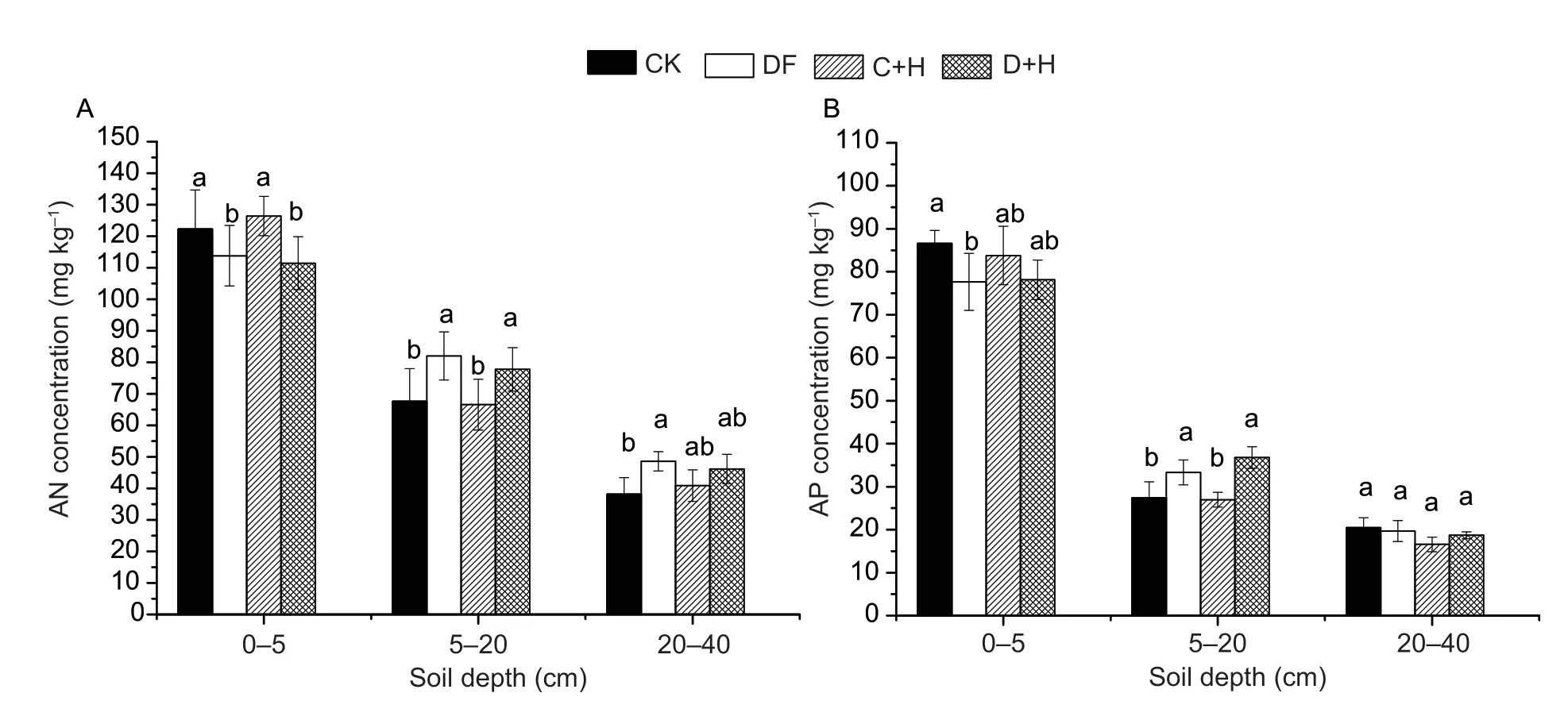
Fig.6 The alkali-hydrolyzable nitrogen (AN) (A) and available phosphorus (AP) (B) contents in soils under different treatments.CK,conventional fertilization;DF,drip fertigation;C+H,conventional fertilization combined with plant hedgerows;D+H,drip fertigation combined with plant hedgerows.Bars are SE (n=3).Treatments indicated by the same letter are not significantly different at the P≤0.05 level on the basis of one-way ANOVA results.
3.5.Pear yields
The pear yields and their components under the different treatments in 2019 and 2020 are shown in Table 3.The 2-yr yield results showed that the pear yields under DF were 8.03 and 12.17% higher than those under CK in 2019 and 2020,respectively.The pear yields under D+H were 6.04 and 11.89% higher than those under C+H in 2019 and 2020,respectively.The main reason for this difference was that drip fertigation increased the number of fruits per pear plant,and those numbers were significantly higher under DF and D+H than under CK and C+H.This difference in the number of fruits per plant among the different treatments also led to different per plant yields.Thus,the yield results also showed that plant hedgerows did not affect the pear yields or any of the yield components.
4.Discussion
Under natural precipitation conditions,nitrogen and phosphorus nutrients in the farmland surface soil are lost to surface runoff,thereby causing AGNPS pollution (Liuet al.2016).Precipitation is the major source of surface runoffand the driving force of nitrogen and phosphorus losses.Different rainfall intensities and frequencies significantly affect the runoff losses of nitrogen and phosphorus.In the 1-year continuous monitoring of orchards in the Tai Lake Basin,the precipitation was 1 186 mm,and the 10-year average annual precipitation was 1 340.51 mm in this Basin from 2011 to 2020.Therefore,the precipitation during the monitoring period was similar to the average annual precipitation,so the monitoring year is representative.The results show that under natural conditions (without hedgerows),surface runoff occurred 24 times from June to September,accounting for approximately 47% of the total number of surface runoff occurrences,and the frequency and total amount of surface runoff were significantly higher than those in other periods.Plant hedgerows are an important factor affecting the occurrence of surface runoff.Researchers in the United States have studied the use of plant hedgerows to control soil erosion since the end of the 20th century,and the results have shown that plant hedgerows can reduce surface runoff by 6% and sediment runoff by 75%(Duchemin and Hogue 2009).In China,Tanget al.(2001)established high-density plant hedgerows on slopes and found that these hedgerows could reduce surface runoffby 50 to 70%.Liaoet al.(2008) establishedPennisetum hydridumhedgerows and found that the plant hedgerows reduced runoff by 59 to 66% and erosion by 71 to 78%compared with traditional orchard management methods.Xiaet al.(2007) used toon and alfalfa hedgerows to reduce the runoff and sediment volumes by 77 and 74%,respectively.Our results showed thatO.japonicusplant hedgerows reduced the overall runoff loss by 19.18% in the river network area of the Tai Lake Basin.The main reason for this reduction is that plant hedgerows not only reduce the amount of surface runoff over time but also increase the minimum daily rainfall required to trigger surface runoff.
Nitrogen and phosphorus losses in farmlands result from multiple factors.In addition to surface runoff caused by rainfall,fertilization is the main nitrogen and phosphorus source in farmlands (Saeed and Sun 2012).Ensuring reasonable fertilization amounts and fertilization methods is the first step by which the nitrogen and phosphorus fluxes leaving farmlands can be reduced and the conversion of nitrogen and phosphorus from nutrients to pollutants can be prevented.These measures are also the keys for reducing and controlling AGNPSs (Xueet al.2020).Traditional fertilization methods mainly involve solid chemical fertilizers.Surface spreading,ditch fertilization and flood irrigation are often used for irrigation and fertilization,and as a result,excessive fertilization,low nitrogen and phosphorus utilization rates and nitrogen and phosphorus losses are common in orchards and other intensive farmlands (Liet al.2013).Drip fertigation using water-soluble liquid fertilizers can effectively improve the precision and uniformity of fertilization,regulate the volume of water required for irrigation,and improve the efficiency of crop water and fertilizer uses in order to improve the crop yields and quality.Drip fertigation is guaranteed to be reliable and has the advantages of saving water and fertilizer and increasing production and efficiency (Liuet al.2019;Dawitet al.2020;Fanet al.2020;Maet al.2020).Liet al.(2020) analyzed 130 papers on the effects of drip fertigation applications published from January 1991 to December 2019,and compared the effects of drip fertigation and farmers’ standard fertilization on crop yields and water productivity.The results showed that drip fertigation can significantly increase crop yields by 12%,water productivity by 26.4% and nitrogen use efficiency by 34.3%.The results reported by Li Ret al.(2015) regarding protected vegetable plots showed that drip fertigation can significantly reduce nitrate nitrogen losses.Denget al.(2010) tracked and monitored the drip fertigation process during banana planting and showed that the AP content in the soil was significantly higher under drip fertigation than under border irrigation or conventional fertilization treatments.Furthermore,the downward vertical migration of phosphorus increased,and the surface runoff losses were significantly reduced.Our results also showed that the concentrations of TN and TP in the surface runoff under drip fertigation were reduced by 31.23 and 25.18%,respectively,compared with those under conventional fertilization.Overall TN and TP losses were reduced by 34.24 and 22.47% under drip fertigation,respectively.These results indicated that drip fertigation significantly reduced the losses of nitrogen and phosphorus through surface runoff in farmland.
Even if fertilization is optimally managed according to crop needs,the nitrogen and phosphorus contents that remain in soils after fertilization inevitably migrate with runoff into surface waters under the action of rainfall and rainfall is the main driving force for surface runoff(Kumwimbaet al.2018).The migration and collection of precipitation in farmlands are always accompanied by the migration and collection of nitrogen and phosphorus in sediments.Therefore,to control AGNPS pollution,it is extremely important to use retention processes to extend the water retention time and retain as much nitrogen and phosphorus as possible before these pollutants enter surface water bodies.Retention processes use physical,biological and engineering methods to intercept,block and strengthen the purification of pollutants,extend their residence times on land,and minimize their entry into water bodies (Xiaet al.2013;Ilyas and Masih 2017).One retention process type involves intercepting pollutants within the farmland (e.g.,biological interception zones),and the other involves intercepting pollutants after they exit the farmland (e.g.,ecological interception ditches and constructed wetlands;Wang Let al.2019).A plant hedgerow is a form of biological interception zone and an effective soil and water conservation measure.It has multiple functions,such as dispersing surface runoff,reducing the flow velocity,increasing infiltration,and intercepting sediments (Luet al.2012).We constructed plant hedgerows in the orchards that not only significantly reduced surface runoff but also reduced nitrogen and phosphorus losses.Compared with no plant hedgerows,plant hedgerows reduced the TN and TP concentrations in surface runoff,and overall TN and TP losses were reduced by 20.60 and 12.64%,respectively.
Drip fertigation not only reduced nitrogen and phosphorus surface runoff losses but also changed the vertical distribution of nitrogen and phosphorus nutrients in farmland soil.In drip fertigation systems,drip arrows are used to directly drip fertilizer into the soil layer 5 cm below the ground surface,thus reducing the accumulation of nutrients in the soil surface layer and decreasing the risk of surface runoff losses.Additionally,pear trees were the cultivated crop analyzed in this study,and the root systems of pear trees are generally distributed in the soil layer 20-40 cm underground.Under conventional fertilization methods,it is difficult for chemical fertilizers to reach these depths directly,and drip fertigation can promote the entry of nitrogen and phosphorus nutrients into the root-intensive areas along with the water,thus promoting the absorption of nutrients by crop roots,increasing fruit yield,and reducing nitrogen and phosphorus losses from surface runoff.Our study also showed that plant hedgerows did not cause significant differences in the AN and AP contents in the soil.Plant hedgerows can intercept runoff and reduce the loss of nitrogen and phosphorus nutrients while also absorbing nutrients from the soil for plant growth.Several studies(Vannoppenet al.2017;Yanget al.2019) have also compared the nutrients retained by plant hedgerows,which tend to absorb very limited nutrients from soil.Plant hedgerows are usually planted along contour lines,far from the fruit tree roots in orchards,so they do not affect the absorption of nutrients by the roots of fruit trees.In this study,the analysis of AN and AP contents in soil showed that plant hedgerows did not reduce the AN and AP contents in each soil layer.Moreover,the annual input of the rotten roots and litter of plant hedgerows as green manure can effectively improve the soil organic matter,nitrogen,phosphorus and other nutrients and the soil aggregate structure (Holdenet al.2019).These results indicated that plant hedgerows not only increased surface coverage and prevented soil erosion but also increased the retention of nitrogen and phosphorus nutrients and improved land productivity.
Drip fertigation and plant hedgerow interception are important measures for preventing and controlling AGNPS pollution.In addition to reducing the nitrogen and phosphorus runoff loss loads and achieving good ecological benefits,these technologies are essential for benefiting farmers,and thus the acceptance of these methods by farmers needs to increase (Zhanget al.2019).Studies have shown that compared to other irrigation and fertilization methods,drip fertigation can not only significantly increase fruit yields and promote the growth and development of fruit trees but it can also improve the migration and storage of water and nutrients in soils and increase water and fertilizer use efficiencies(Liet al.2017;Caoet al.2018).The results of this study also show that compared to conventional fertilization,the pear yields obtained under drip fertigation increased by 8.03 and 12.17% in 2019 and 2020,respectively.These results were mainly due to the coupling of water and fertilizer applications through drip fertigation.Under drip fertigation,nutrients move to the deeper soil layers as the water migrates,thus better meeting the nutrient requirements of the fruit tree roots,significantly improving the physiological and nutritional status of the fruit trees,promoting the absorption of water and nutrients by the fruit trees,and increasing the number of fruits per plant.Some studies have also shown that drip fertigation can regulate photosynthesis by affecting leaf pigments,stomatal behavior,biological enzyme activities and other factors,thereby affecting fruit yields and water and fertilizer use efficiencies (Wanget al.2012;Chenet al.2014).In addition to increasing the fruit yield and impacting the migration and transformation of water and nutrients,our experiments also proved that drip fertigation can save labor,reduce costs and increase farmers’income.This technology has been effectively promoted and applied in intensive farmlands,such as orchards.In contrast to drip fertigation techniques,plant hedgerows are a traditional soil and water conservation measure that not only disperses surface runoff and intercepts sediment(Liuet al.2013) but also optimizes the ecological planting modes of orchards and creates structures on which microorganisms and beneficial insects can be sustained.A good habitat increases the biodiversity of an orchard system,improves the natural regulation ability of the ecosystem,and reduces fruit tree disease and insect pest incidences (Doriozet al.2006;Mihara 2006;Mutegiet al.2008).However,our results also show that the plant hedgerows in the study area did not directly increase pear yields,which may be due to the short time period of the study,so the economic benefits of plant hedgerows may not have appeared yet.
5.Conclusion
In this study,we evaluated the effects of drip fertigation and plant hedgerow interception on the prevention and control of nitrogen and phosphorus losses and fruit yields in a highly intensive and highly fertilized pear orchard.The results suggested that drip fertigation andOphiopogonhedgerows reduced the amounts of TN and TP lost to runoff.Drip fertigation also increased pear yields,and drip fertigation combined with plant hedgerows yielded the best reduction effect for nitrogen and phosphorus losses.The overall losses of TN and TP were reduced by 45.38 and 36.81%,respectively,compared with those for conventional fertilization without plant hedgerows.These results indicate that the dual implementation of drip fertigation and plant hedgerows in orchards can effectively reduce the amounts of nitrogen and phosphorus lost to runoff,mitigate the discharge of AGNPS pollutants,and increase fruit yields.Thus,these methods have great promotional value in practical applications.
Acknowledgements
This work was supported by the International S&T Cooperation Program of Shanghai,China (20390731200)and the Major Science and Technology Program for Water Pollution Control and Treatment,China (2017ZX07205).We are grateful to Shanghai Huawei Water Saving Irrigation Co.,Ltd.,China,for installing the drip fertigation system.
Declaration of competing interest
The authors declare that they have no conflict of interest.
杂志排行
Journal of Integrative Agriculture的其它文章
- A 314-bp SlNE insertion in the ZNF2 promoter region may act as a repressor related to regulation of fat deposition in pigs
- An optimized protocol using Steedman’s wax for high-sensitivity RNA in situ hybridization in shoot apical meristems and flower buds of cucumber
- Characterization of subunits encoded by SnRK1 and dissection of combinations among these subunits in sorghum (Sorghum bicolor L.)
- The role of time preferences in contract breach: Evidence from Chinese poultry farmers participating in contract farming
- Optimal design of culling compensation policy under the African swine fever — Based on simulations of typical pig farms in China
- Different genotypes regulate the microbial community structure in the soybean rhizosphere
